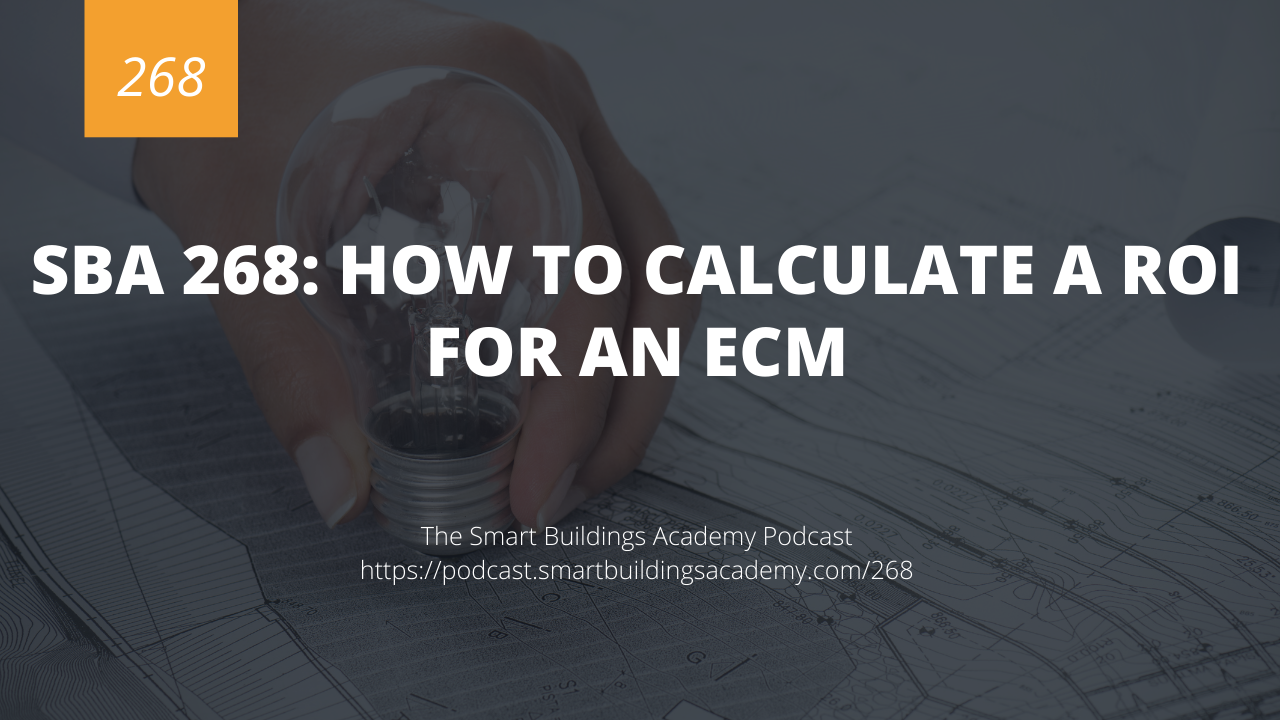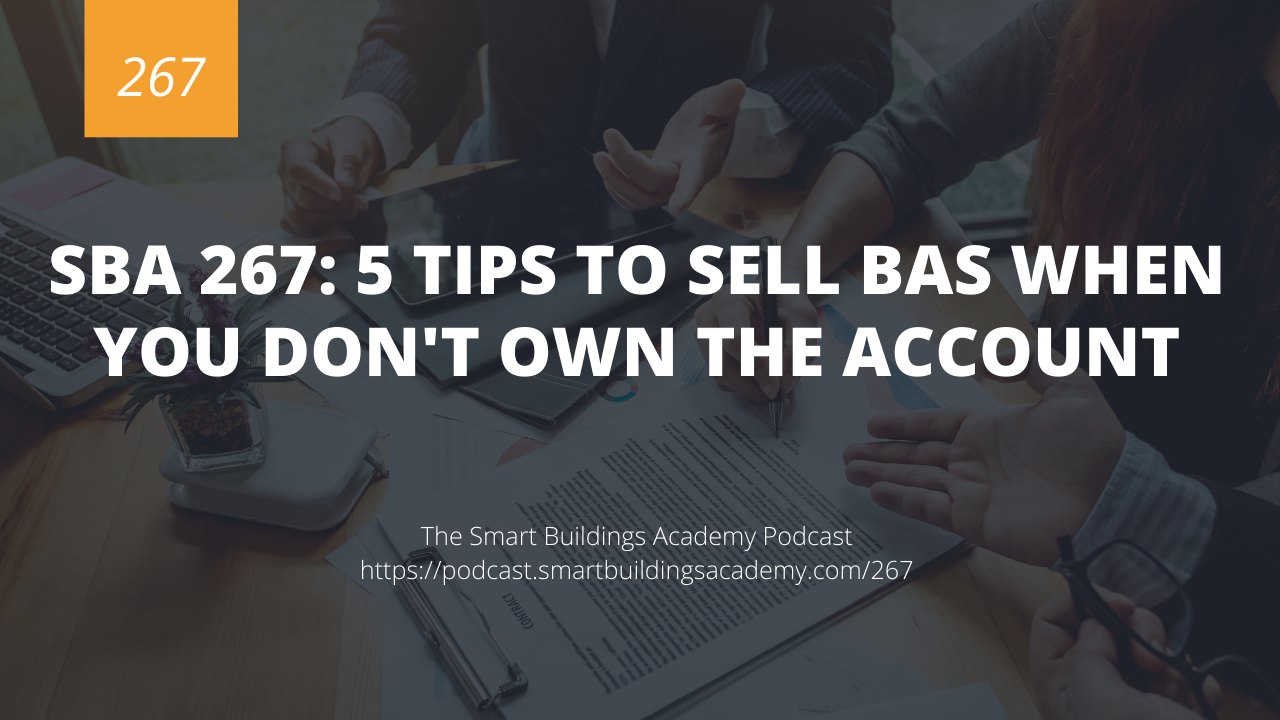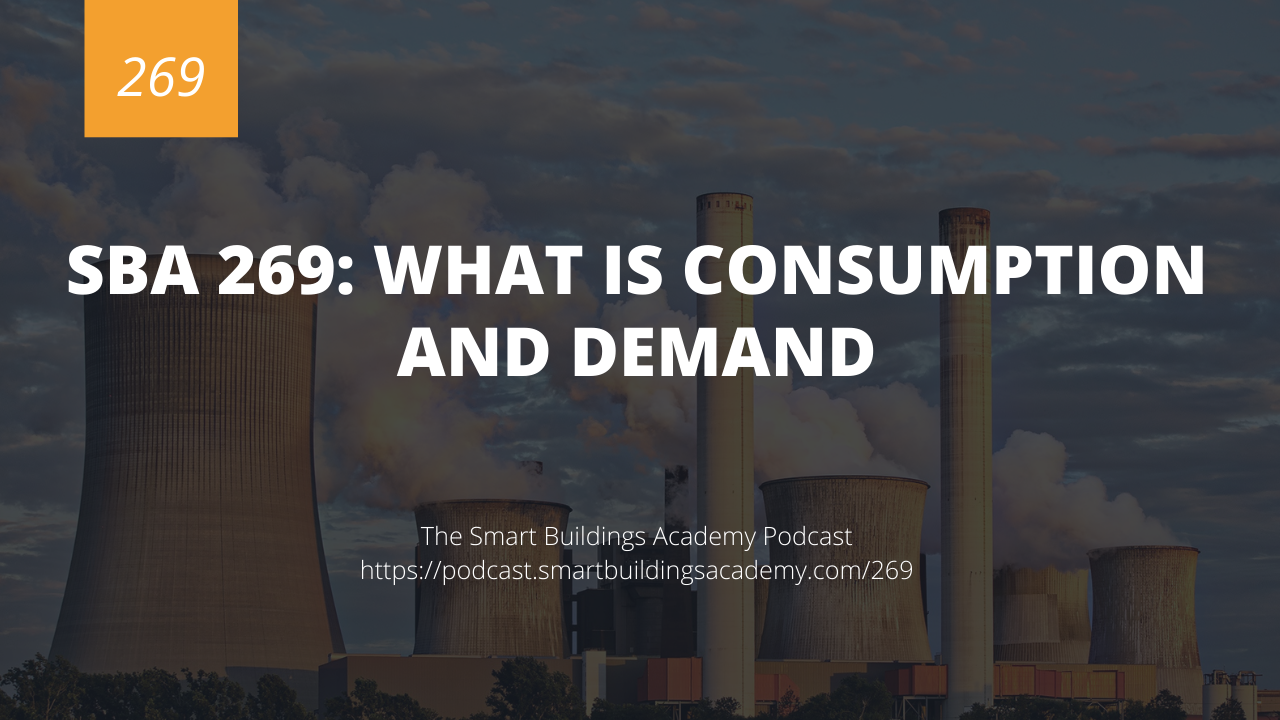Building automation professionals should understand how to calculate the return on investment and payback period for building automation energy conservation measures.
In this episode we explore the fundamentals of return on investment calculations for energy conservation measures.
Click here to download or listen to this episode now.
Resources mentioned in this episode


Transcript
Phil Zito 0:00
This is the smart buildings Academy podcast with Phil Zito Episode 268. Hey folks, Phil Zito here and welcome to Episode 268 of the smart buildings Academy podcast. And in this episode, we are going to be talking through how to calculate a return on investment for an energy conservation measure. Now I know that energy is not the biggest most important thing right now everyone's kind of focused on re occupancy IQ, safe buildings, etc. However, we do see the price of gasoline starting to creep up in the United States, if you're over in another country, definitely the cost of energy is much higher than it is here in the United States. And it's only a matter of time until the pendulum swings. And we are once again focused on energy efficiency. So in today's episode, we are going to really dive into this calculation here that I feel a lot of folks don't understand. And we really should understand this. From a building automation perspective, especially with a lot of the sequences we implement, like vfds, or demand ventilation, or trim In response, just any sequence that we can potentially implement, that would go and reduce energy consumption, as well as energy demand. And those are two totally different things. We really need to understand these because by understanding these, we then are able to go and make valid explanations, or at least quantitative explanations for why our customers should invest in our energy conservation measures. So that being said, everything will be found at podcast at smart buildings academy.com forward slash 268. Once again, this podcast has smart buildings academy.com, four slash 268. Keep an eye out for our upcoming Labor Day Sale 20% off courses that will be coming if you're on our mailing list, probably right before Labor Day. But if not just pay attention to the site up in the header there will be a discount code for that. Alright, so why would we want to calculate ROI for an ECM as a building automation professional like as a technician, as a salesperson as manager? Why would you want to do this, because as I mentioned in our previous two episodes, how to scope a retrofit project in 266, and five tips to sell VA s, when you don't own the account in 267, I really feel that we're going to be entering a retrofit market, we're going to see not as many buildings being built. And because of that, we are going to have to go and do retrofits, well, what do we have to do when we do retrofits, we have to go and provide some justification. And that's where this comes in. So in Episode 269, and this is kind of bad planning on my part, but in Episode 60 to 69, we're going to discuss what consumption and demand is, but I'm going to give you like a super high level. So demand is how much power basically you need. In order to just start and run things. It's basically the capacity you need. And so the utility is required to provide a certain amount of demand capacity based on your historical performance, whether you use that demand or not. Now, consumption is actually what you use that. So demand is measured in kilowatts, at least in the States. And consumption is measured in kilowatt hours, at least in the United States. Now, with all that being said, we need a way to evaluate our energy conservation measures and say that, hey, this conservation measure makes sense, or Hey, it does not. And so what I like to do first is I like to determine my payback period. So basically, what we do is we look at the total initial investment. And then we look at our annual savings and our annual savings could be a reduced reduction in consumption or a reduction in demand. So basically, our demand, we times that times our reduction in demand, we times basically against our demand rate, and then our reduction in consumption, we tie, we multiply that against our consumption, right? That gives us our annual savings. Now we can do this through modeling, we can do this through energy reduction calculations, we can do this through BCU reduction calculations, there's a variety of ways we can do this. It really just depends on what the retrofit is. But once we have that annual savings number, then we can go and divide that into our total initial investment and that's going to give us our initial payback, right.
Phil Zito 4:47
So that's going to be like, Is it a two year payback a one year payback, and oftentimes the payback is your initial number. And it's what you use in order to just bring it to the table. So Oftentimes things are stacked by payback before they're even stacked by ROI, and ROI and payback are different. And we'll see how that is in just a second. Now, once we get to return on investment, there's several different things we need to know there's gross return on investment, net return on investment, gross average rate of return and net average rate of return, these are the big things we want to focus it on. So gross return on investment, this is simply going to be the total savings produced by the energy conservation measure over its lifetime divided by the initial investment, and that's going to give us a percentage. Now net return is going to basically have it's going to be the How do I say this is basically the same thing as gross, except what we're doing is we're taking the cost out, we're taking the cost of the investment out. So basically, let's say that we had a 10 year project. And each year it saves $1,000. Right? So 10 years $1,000, an initial investment of $2,000. Okay, so 10 years, times 1000 is 10,000 10,000 divided by 2000. Right? 2000 is our cost, right? So let me type this into my calculator, because, as you all know, I am not good at math, which is kind of funny. So 10,000 divided by 2000 times 100, that gives us a 500%. Gross return across the life cycle of this energy conservation measure. Now, if we want to get net return, which is going to factor in and these numbers are important to remember them, all right, that 500 that's our gross return, our net return is going to be 10,000 minus 2000. So that's 8000 divided by 2000. Right? So there we go. We're gonna look at what was it? Oh, no, no, no, no, no, no, no, no, hold on here. Yeah, I had it right. Did No. NET return. Should be This is why I don't do math on podcasts works. Because it's terrible. It's really bad. Starting net return is going to be 10,000. Alright, minus 2000. Minus 2000. Should be 8000 divided by 2000. which will give us four. So we will have Yeah, I was doing my math, right. That's good. 400%. So net return is 400%. So net return factors in the cost and everything right, so we're looking at that. Now with this, we can then calculate our average rate of return, we can either calculate our gross rate of return or our net average rate of return. Now remember that our time period was 10 years, and our gross return was 500%. So 500% divided by 10 gives us a 50%. rate of return. That's pretty freakin nice. 50%. Right, wow.
Phil Zito 8:33
But that's, that's not what we're most concerned about, we want to be concerned about our net average rate of return. So we're once again, we're going to look at 400 divided by 10, that's going to give us 40. So 40% is our net average rate of return. So then what we say is if we're investing this money into the market, right, if we invest this money into the market, are we going to make 40% return on that money across that time period? And, you know, maybe that yes, maybe no, but we want to understand that because once we understand that, then we can say, Okay, this is a great investment, there's no way we're going to make this amount of money in the market. And we should go and improve our facility and do this energy conservation measure. Or you might run into the opposite, which is, hey, there's no way we're not like it comes back like negative 5%. And you're like, there's no way we're going to invest in this. We're going to lose money. It I mean, if we put our money in the market and did nothing to it, like if we put it in a savings account, it would make more than this energy conservation measure. So we need to be aware of that and that's how a lot of finance decision oriented folks make their decisions. Now for those of you who are Tech's you're probably your eyes are glazing over right now. You're like why do I need to know this? Because And I'm gonna say this again and again and again. And I've said throughout our podcast series, especially if you're in service, it is your job to create work for yourself, do not rely on the salespeople to do it for you understand these conversation pieces, these are superduper simple equations that you can use to have a discussion with the facility manager to at least get them to consider having a discussion with the salesperson, I'm not saying you have to go and create, you know, energy calcs and energy spreadsheets and you need to become an energy engineer. That's not what I'm saying. But by at least being able to financially justify looking at an investment, you'll be able to bring the sales team to the table, which then will be able to get you some retrofit work, which then will hold you through. If your service work, it's light. So you need to think about this plus, it makes you immensely valuable, as a technical person to be able to bring business in the door. If I look at any industry, you know, doctors offices, lawyers, offices, etc. Oftentimes, the highest paid lawyer, highest paid doctor are not the ones who are necessarily the most technically skilled, but they're typically the ones who have the best relationships and can bring the most business into the firmer into the practice. So be cognizant of that, as a technical person, your ability to bring business in the door, even if you're not closing it is still extremely valuable. The other thing I want to discuss that we didn't really mention here is the impact of grants the impact of a variety of different things that can reduce that initial investment. So understand your local utilities understand what their rebate programs are, understand what grants exist, understand what exists to reduce that initial investment cost, because once you understand that, then you're then able to go and add that in to the equation and maybe make the payback and ROI even more favorable for your customers. Alright, folks, I know this is a little out of what we normally talk about. But I really, really, really firmly believe that it's incredibly important for us to focus on retrofits in this kind of downtime right now. Well as construction season wraps up, because I think delta is going to get worse. You know the COVID variant. I think we are going to see reduction in construction. We may even see some lockdowns again. And one of the best ways for us to go and keep our pipe full and keep our businesses afloat and keep ourselves employed is to create retrofit work that is independent of like large construction events, which may be shut down because retrofit work is nice, you know, if buildings unoccupied, you could potentially go in to do the retrofit work because there's not a large construction event. Alright folks, if you have any questions, do not hesitate to hit me up. I love to hear from you. And I will see you in our next episode where we'll be discussing what is consumption and demand. Thanks, son.
Unknown Speaker 13:02
Take care.





